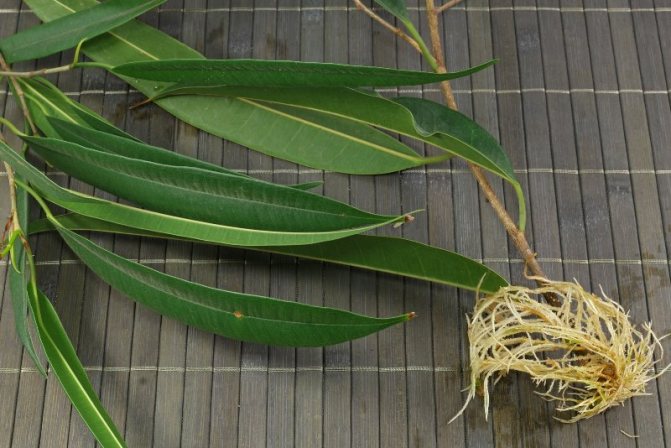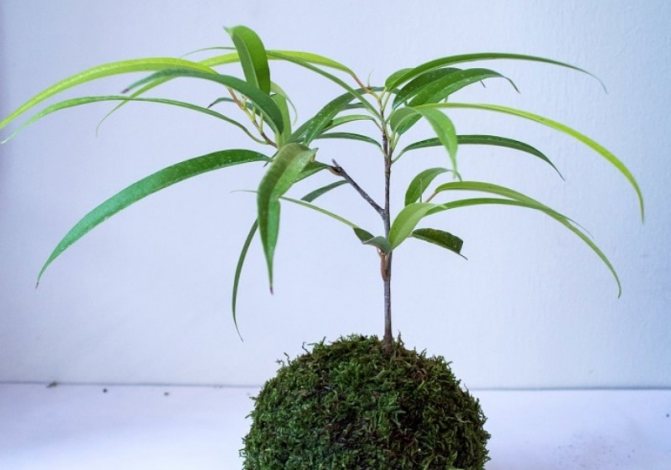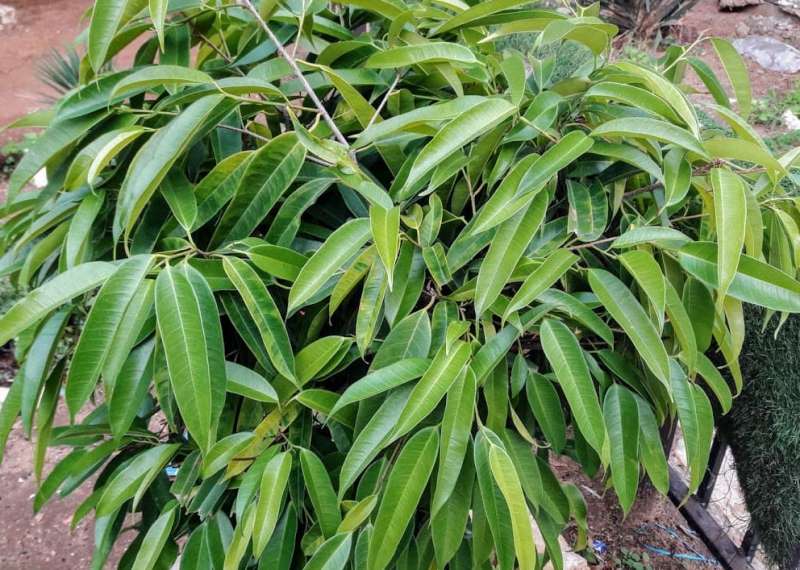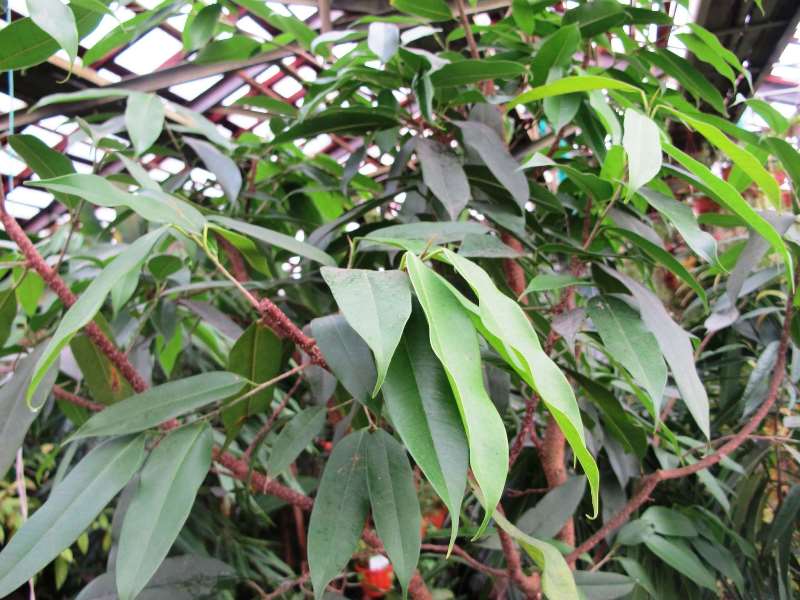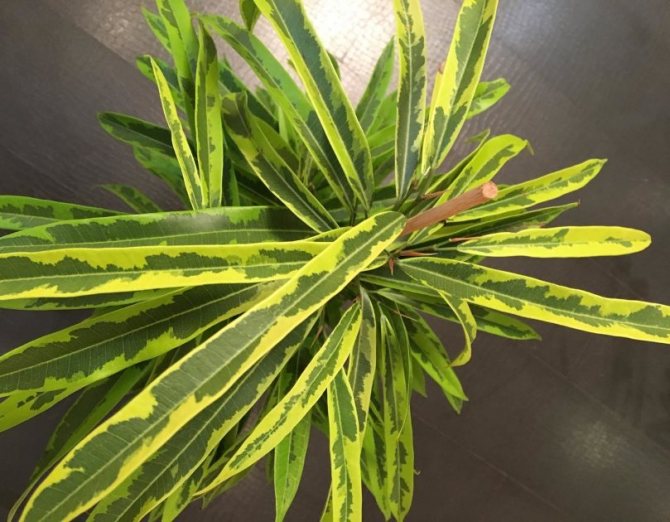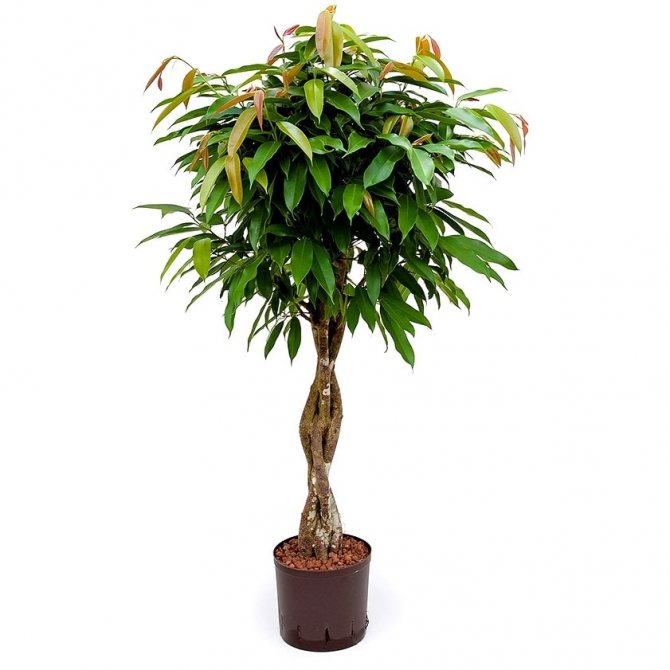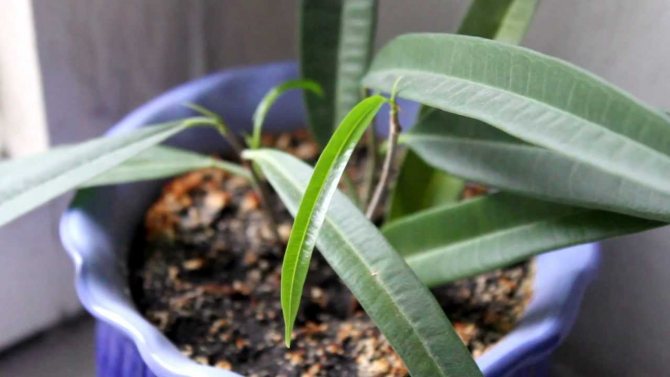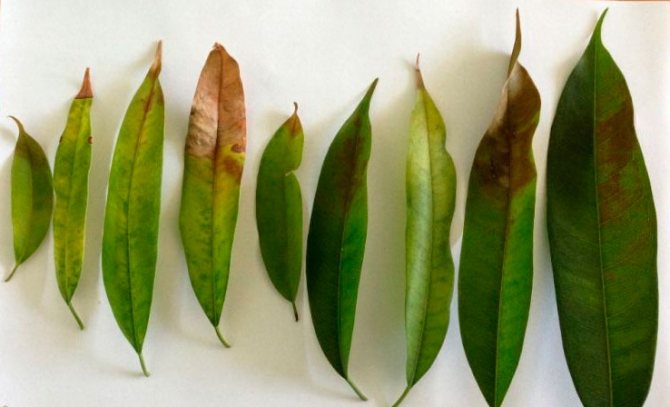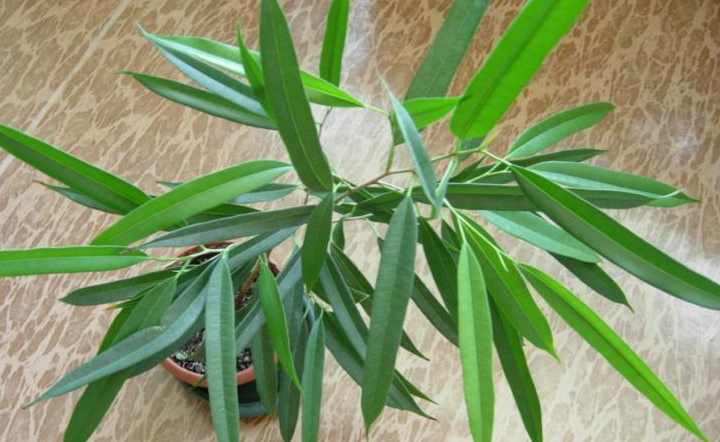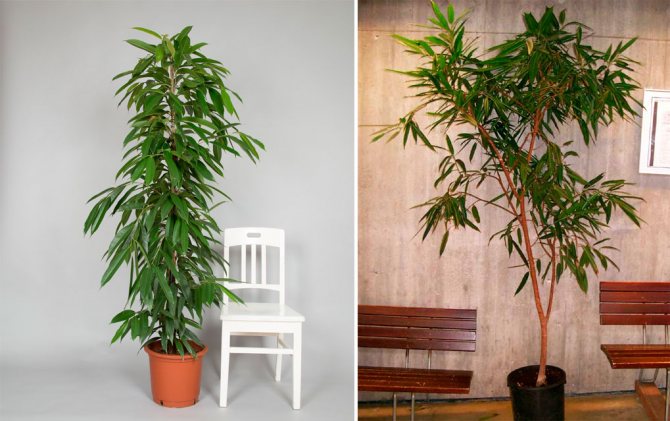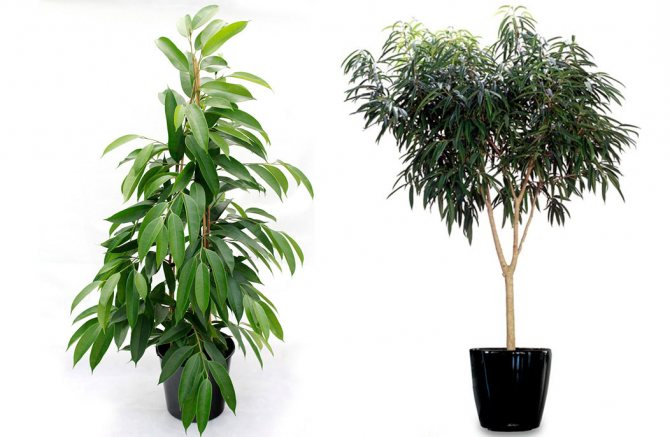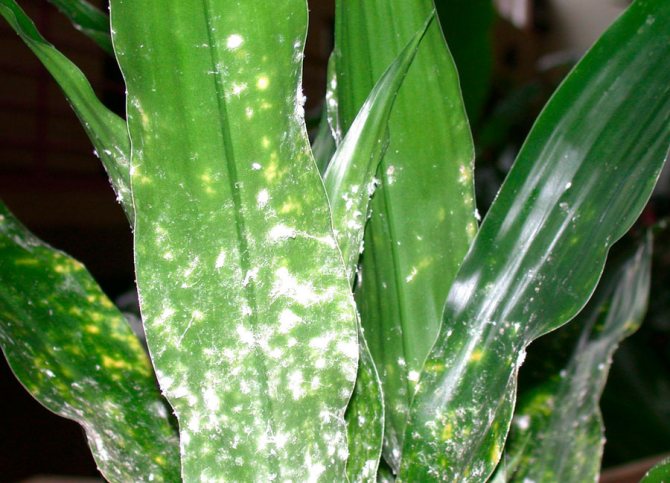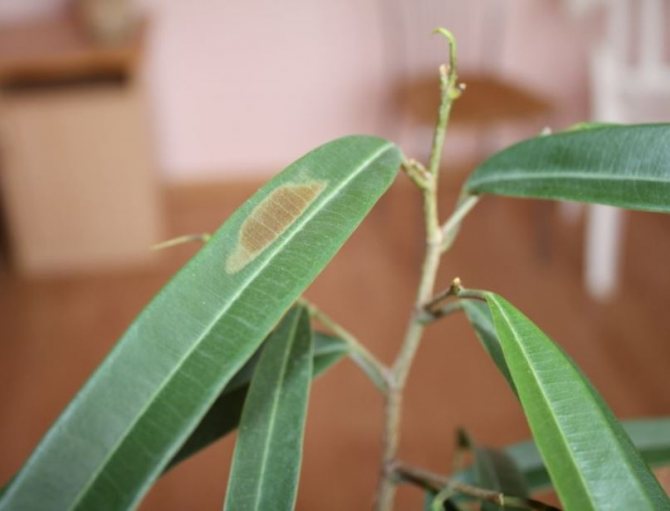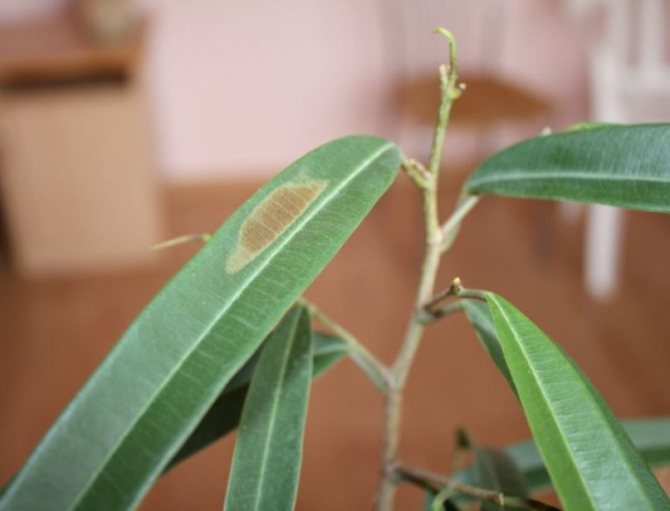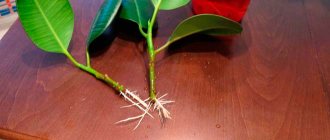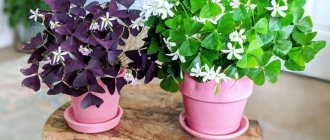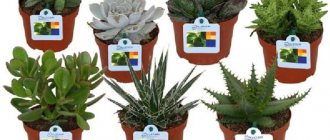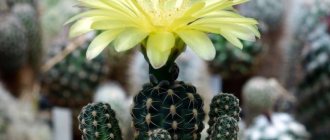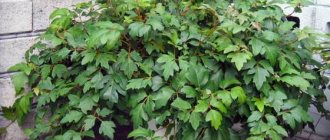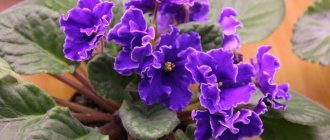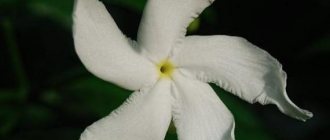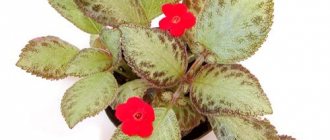»Flowers» Ficus Ali (Benedict) - decorative tree in the house
0
89
Article rating
In nature, ficus Ali grows in the tropical forests of Southeast Asia: from Nepal and the Himalayas to the Philippines and Vietnam. The Hawaiian Islands are officially considered the birthplace of the species. Today, this ornamental tree is even grown in parks in the United States and is loved by flower growers around the world as a home and office decoration.
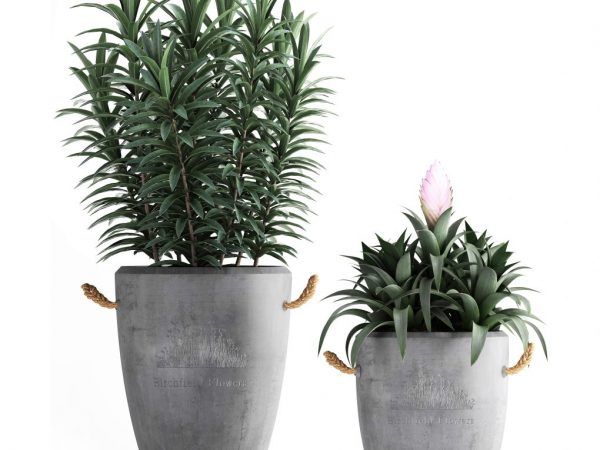
Ficus Ali Benedict
Origin story
The presented species was first described by a gardener from the Netherlands Simon Binnendijki or Bennedikt in the 19th century, from which it got its name. The following names are also common: ficus Benedict / Binnendiyka Ali and Ivolistny. The last nickname comes from the characteristic shape of the leaves.
Domestic low varieties were bred artificially, so Ali can be considered a small hybrid of the Binnedijk ficus. This small tree is valued for its spreading crown, thanks to which it looks advantageous both in single plantings and in compositions with other flowers.
How to choose the store and its cost
Ali Bennendijk's species includes several varieties, so before buying a plant, it is recommended to look into the catalog to know exactly what you have purchased.
The following basic rules for choosing a ficus in a store can be distinguished:
- The best time to buy is spring or summer. In the warm season, the plant will take root faster and adapt to the microclimate at home. In winter, you will need to organize additional lighting, a certain humidity and temperature, which can be quite troublesome. Ficuses do not like a sudden change of place - because of this, they can shed their foliage.
- If the plant is healthy, then you can not be guided by the size - the strength depends rather on the variety. However, it is believed that adult specimens find it more difficult to adapt to new conditions, and adaptation takes longer.
- Leaves, stem and roots should be examined for disease. Mealybug lesions are especially common.
- It is advisable to purchase flowers that have just been brought to the store, which did not have time to stand there for a long time.
There is a little trick: the flower can be shaken - if a lot of leaves fall, then you should not buy the selected specimen.
The cost depends on the size and grade. On average, the price of Ali ficuses up to 30 cm in height reaches 1000 rubles, and meter trees can cost from 4000 rubles.
Signs and superstitions
Amstel ficus is mentioned in Asian and Slavic culture. Moreover, this flower appears in diametrically different light, so superstitious people have to make a difficult choice. In Asia, ficus is considered a useful plant that brings good luck and wealth to the home. On its basis, alcoholic infusions are made to relieve inflammatory processes. In Slavic culture, this flower is considered a lovebird, driving men out of the house.
In any case, Ali's stately ficus will be a wonderful decoration for the home. Its sprawling high crown makes it an independent green element of the interior. For flower growers, it will be a godsend for creativity, since pruning and shaping branches are exciting activities. Compliance with simple rules of care will allow you to admire a beautiful noble flower for many years.
Description of ficus
A large evergreen tree, which in nature can grow up to 15-20 m, but decorative selection ficuses, on average, reach only 2 m.
The trunk is naked, covered with dark brown bark with light streaks.
The leaves and crown resemble willow or oleander - a narrow elongated shape, pointed tips, drooping branches. The color of the foliage depends on the variety and ranges from a solid dark green to variegated. In length, leaf blades can reach 30 cm.
Ficus species, photos and names
The beautiful evergreen ficus plant belongs to the mulberry family. Plants growing naturally in New Guinea, Southeast Asia and the Solomon Islands can be both trees and shrubs. Depending on the type, ficus can have green or bicolored leaves up to 70 cm in size. Small flowers of the plant are located on simplified perianths.
In nature, ficuses can grow up to 40 meters long, and their trunk diameter can reach 5 meters. There are climbing and creeping plant species. In total, there are more than 1000 varieties of ficuses. However, much less is grown at home. We will consider ficuses known in amateur floriculture in our article today.
Popular types of ficuses
Rubbery ficus is one of the most popular and unpretentious species of this genus of mulberry plants. It is distinguished by a weakly branching trunk. which at home can reach two meters. Leathery and glossy elliptical leaves are slightly pointed at the tip. The greyish-green crown of the tree is rough and dotted with horizontal grooves. In humid rooms, the tree gives air roots. This type of ficus has different varieties, which mainly differ in the color of the leaves:
- The Black Prince is a black-leaved plant.
- The Doecheri variety is distinguished by the presence of pink spots and a red vein in the middle of the leaf.
- Variety "Variegata" has beautiful green leaves, along the edges of which there is a cream edging.
- The Robusta variety is a plant with large, glossy, deep green leaves.
Ficus Benjamin is an evergreen tree with slender shoots that can grow up to 10-20 meters in nature. At home, the bush reaches a height of three meters. The gray-beige branched crown of the plant has regular shapes. Oblong sheets reach 5-20 cm in length and 2-5 cm in width. They can be monochromatic or two-colored, oval, ovoid, or spiral-shaped. The crown of the tree is so dense that sometimes the trunk is not visible because of it. Thanks to the aerial roots growing out of their shoots, you can make beautiful bindings and give the tree unusual shapes.
The creeping ficus is a miniature creeping shrub characterized by long stems on which additional roots are formed. On the green surface of its heart-shaped, hard leaves, a reticulated pattern of yellow hue is formed. Thanks to its suction cups, the plant can grow on trees or supports.
Dwarf ficus or Pumila White is a vine with long, creeping shoots. Asymmetric leaves are oval-heart-shaped and are located on stems 5 cm thick. The rough and wrinkled surface of the leaves is covered with a mesh pattern. The plant completely covers the soil with a carpet, growing to the ground with its numerous roots.
Lyre ficus is distinguished by large leaves of a light green hue. In young plants, they are covered with wax, and in shape resemble the silhouette of a violin. Each leaf reaches 60 cm in length and 30 cm in width. Green leaves with a white speck in the middle have a pronounced vein. The erect trunk of a plant in nature grows up to 12 m.
Ficus Rubiginoza or rusty is a small spreading tree with red shoots.Aerial roots form in the lower part of the crown, and bright pink pubescent buds grow at the top of the tree. The rather large leaves of the plant are dark green on top, and reddish brown on the underside.
Ficus varifolia got its name due to the fact that on its branches you can see leaves of completely different shapes. The shrub growing up to one meter has a tree-like stem and leathery leaves. Their dark green background may have brown spots. The shrub bears fruit reminiscent of olives, which in no case should be eaten.
Ficus Melani is considered a sacred tree in Indonesia. The young plant has an underdeveloped crown. The trunk of the plant is covered with leathery, elliptical dark green leaves and aerial roots reaching the ground. At home, the plant does not bloom, but forms syconium fruits.
Ficus Karika or indoor fig is a small deciduous shrub with a spreading crown. It is distinguished by a brown-gray thick trunk and irregularly shaped toothed leaves. Each leaf is covered with light yellow or white veins. With proper home care, you can achieve flowering and fruiting of figs. The flowers of the plant are barely noticeable, but the fruits or wine berries resemble spherical compound fruits. In autumn, this type of ficus can shed its leaves.
Main varieties
All varieties are very similar in appearance and differ only in the width and color of the leaves. The ficus Ali has the widest leaf blade.
Amstel King
It has a spherical crown and a uniform dark green color of the leaves. The main difference from other varieties is the width of the leaf blade of 7 cm.
Amstel Gold
The leaves of Amstel Gold stand out immediately: the colors are scattered along the entire length and shimmers from yellow-green to light green. Areas of different shades are randomly located.
Such a spectacular color is called "variegated" or "spotted", which is formed due to the presence of mutant cells that do not synthesize chlorophyll.
Amstel Queen
The variety is practically indistinguishable from Amstel King - the leaves are only slightly wider and occupy an intermediate position between King and Ali.
Ficus and crown appearance
Ficus Ali is a hybrid of the Binnenndian ficus, its mini-copy, artificially bred for indoor cultivation. This is an ornamental tree. Its progenitor at home in the Indonesian forests grows up to 25 meters. And the selection tracing paper is miniature - on average, its height is 2 meters.
Ali's (also known as Benjamin's) leaves are dark green or variegated, with numerous veins, depending on the variety. Shaped like willow or oleander leaves. They are glossy, long and narrow. The trunk is high, flat, with dark bark. The branches are drooping, the more they resemble a willow.
As the tree grows, the lower leaves die off, exposing the trunk. An adult ficus is a small tree with a rounded crown and a long trunk.
It is not difficult to form the trunk and the shape of the crown of a tree. It is enough to cut off the shoots in the spring to preserve the compactness of the specimen and the splendor of its crown. A stunning effect can be achieved by other methods.
Simple bole
In a young plant, the lateral shoots are first cut off, allowing only five central ones to grow. Then pinch the top of the most important of them, and cut the side shoots in the shape of a ball. The trunk will need a support for some time, which can then be removed.
Bunk bole
The plant is divided into three levels. On the top and bottom, trimming is done in the form of a ball. And in the middle part, side shoots are removed.
Ficus braiding
Two or three small cuttings are planted in one pot. From two, a spiral is obtained, and from three, a pigtail. The weave must be loose to allow the tree to grow. Excess leaves and shoots are removed.
Growing conditions
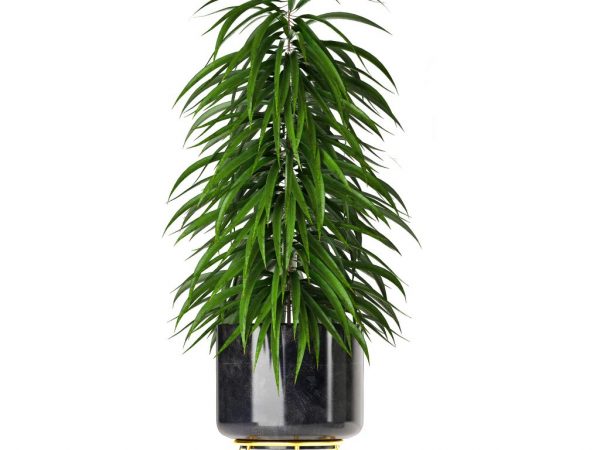

Good and fast growing
The view is quite unpretentious, so it is easy to take care of it both at home and in office premises.
Temperature
Comfortable temperature is 22-24⁰С. In winter, it is advisable to lower the indicators to 16⁰С.
If the ficus is not watered, then a decrease to 10 ° C is permissible. With further cooling, the roots already freeze and the plant may die.
The warmth in the room should increase with increasing illumination and length of daylight hours. The upper comfort limit is 27 ° C.
The pot should not be placed near heaters or under air conditioners, in drafts, but the room should be regularly ventilated.
Humidity
Ficus requires medium to high humidity. Optimal - 50-70%.
In summer, the leaves should be sprayed twice a day, and an adult plant is advised to periodically take a warm shower. In this case, the water should be soft, separated and at room temperature.
Lighting
Subtropical species require bright lighting for 10-12 hours with diffused sunlight.
For varieties with leaves of a uniform dark green color, partial shade is acceptable (eastern windows), and variegated specimens are more demanding on lighting. Optimal placement of the pot on the southeast windows.
If the flower stands in the back of the room, then it is necessary to organize the lighting.
Note! Direct sunlight can burn the leaf blades.
Plant transplant rules
Like all home flowers, you need to transplant the ficus as it grows.
Up to 15 years old, the transplant is carried out annually - in February-March. The new pot should be a couple of centimeters larger than the old one. The earth can remain the same - just adding fresh on top.
To form the soil, it is necessary to mix fertile soil or peat, charcoal and fine sand - all in equal proportions.
Ficus transplant is carried out according to the following algorithm:
- The land needs to be watered;
- In a new pot, soil 2-3 cm thick is poured onto the drainage layer;
- The container with the flower is turned down and the trunk with the roots is removed with the help of gentle movements - by tapping on the pot;
- Large specimens, whose earth is quite dense, can be separated from the walls of the pot with a knife or spatula, and the tree itself can be pulled out by the trunk;
- Ficus is placed in a new container and sprinkled with soil from the sides.
The transplanted plant should be left for 1-2 days in partial shade for adaptation, and then watered and rearranged to its usual place.
Transfer
For the transplant, a pot is selected, which will be only slightly larger than the previous one. The flower should be very carefully removed from the pot (for this it is recommended to soak an earthen lump). Next, you need to separate the roots from the ground and carefully examine them. In the event that there are sick, rotten or dried roots, get rid of them immediately. After that, place the flower in a pot, add soil and water.
When the procedure is complete, do not touch your pet for a while. He needs peace to cope with stress.
Home care
Watering
For irrigation, it is necessary to use settled water. The main principle: less is better than more.
Watering the ficus should be when the top of the soil dries up a couple of centimeters. In winter, it is better to let the soil dry out deeper.
As a rule, in the warm season, it is enough to water 2 times a week. All the water that flows into the pan must be poured out, otherwise the roots may start to rot.
Top dressing
It is recommended to feed ficus with supplements for deciduous plants every two weeks during the period of active growth - from March to August-September.
It can be both organic and mineral fertilizers, as well as a combination of dressings (alternating components).
Attention! All funds are applied only when watering, not from a spray bottle.
Crown formation
The main pruning of the crown is carried out in the spring.Young ficuses grow quickly, but it will be difficult to give shape to an old plant.
- In March and early April, the protruding and inward long branches are shortened.
- In the summer months, shoots are pinched, which are knocked out of the general mass.
Timely cutting allows you to avoid stretching the tree and make a real design object out of foliage.
Formation is necessary, because the main characteristic of this ornamental plant is a spreading tent of leaves.
There can be many options for the crown: simple pruning of lateral shoots to a rounded shape, dividing into levels, interweaving of two copies in one pot.
The procedure is carried out with a sharp instrument. It is recommended to moisten the cut sites for the first time and sprinkle with activated carbon. With the remaining cuttings, the ficus can be further propagated.
Important! Pruning is not carried out from October to February, that is, during the dormant period.
Features of caring for a flower at home
Ficus lyre - home care
The natural habitat of this plant is hot countries. This fact explains the thermophilicity of the tree. In order for the ficus to actively grow in an office or apartment and delight with an abundance of greenery, it needs to provide conditions that would be as close to natural as possible.
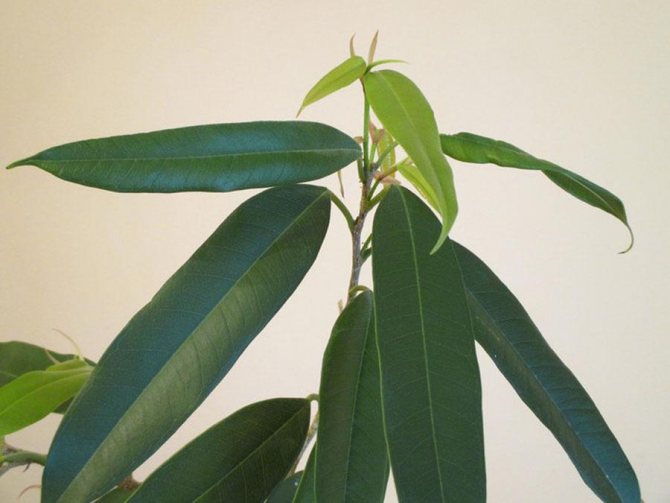

Binnendijka at home
Temperature
Ficus Benedict feels best when the air temperature is 22-24 ℃ above zero. In winter, it is better not to keep the flower pot on the windowsill. Roots may suffer from freezing of the soil. This leads to diseases, as a result of which the ficus sheds its leaves.
Wood also needs to be protected from heaters and radiators. Hot streams from appliances dry the air, causing overheating.
Lighting
The level of required lighting for different varieties of ficus differs:
- If the leaves of the tree are painted in dark green shades, then there are no increased requirements for light. Moreover, the flower can live at a short distance from the window or in partial shade. Such features of the content will reduce the growth rate, but otherwise there will be no problems.
- If the ficus has spotted light leaves, then it is important to provide good lighting to preserve its beauty. The pot can be placed near the southeast or south window.
Important information! Direct sunlight should be avoided. Otherwise, burns will appear on the leaves.
Watering
The frequency of watering and the required amount of water depends on the season and the size of the ficus of Binnendiyka Ali itself. Experienced growers are advised to check the condition of the topsoil. If it's dry, it's time to water.
Note! This flower does not tolerate excess moisture, as this causes rotting of the root system. To prevent this, the water accumulated in the sump after watering must be drained.
Spraying
Dust constantly accumulates on smooth, wide leaves. In order to get rid of contamination, the plant should be periodically sprayed. During the summer, this procedure can be repeated twice a day. You can use cool water. In the absence of heat, spraying is performed less often - about 2 times a week.
Humidity
Such a characteristic as air humidity has little effect on the growth activity of a flower. It is enough to maintain a favorable microclimate of a room with a humidity of about 50-70%.
Priming
For growing ficus benedict Ali, ready-made soil for palms or ficuses is well suited. However, you can make a plant-friendly soil yourself. So, for young plants, mix an equal amount of peat, turf and sand. Acidic and alkaline soils are not suitable for ficuses.
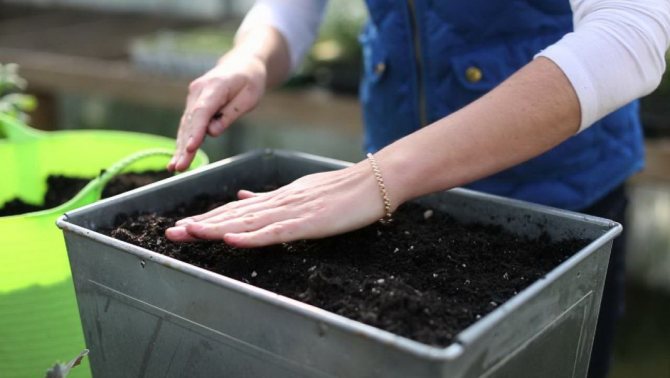

Planting ficus
Top dressing
The period of active growth of this variety occurs in the summer (from March to October). During these months, feeding is carried out every 10-12 days. As fertilizers, organic compounds and mineral complexes are required. The most effective way is to alternate these funds.
Diseases and pests
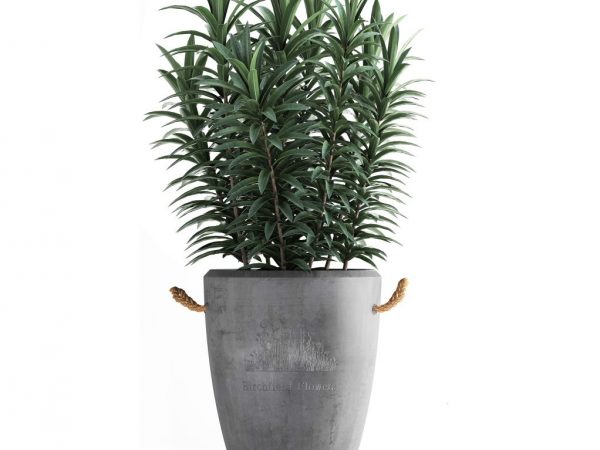

Ficus needs light
Proper care is often enough to keep the plant healthy. It is on the conditions of detention that special attention should be paid if the leaves dry, change color or fall off.
Major mistakes:
- overflow or hypothermia of the soil - roots rot, ficus drops leaves;
- lack of light - the leaves turn pale and turn yellow;
- frequent rearrangement of the pot and turns relative to a window or other light source, lack of fertilizer - growth retardation;
- active sun - curling and drying of leaves;
- excessive feeding, dry air, violation of the temperature regime - the appearance of brown spots on the leaves;
- fungus - dark spots at the bottom of the leaves (the affected parts must be cut off);
- a sharp change in the microclimate - leaf discharge.
To normalize the state of the plant, it is enough to re-establish care.
A separate category of diseases is the attack of pests.
Spider mite - the flower is covered with a whitish cobweb, the leaves are especially affected. The parasite does not tolerate moisture, so the ficus must be thoroughly rinsed with water, and then it can be covered with a film to create a greenhouse effect.
Scabbard - attaches to the leaves and sucks out the juice, as a result of which they turn pale and fall off.
For treatment, foliage and shoots are washed with running water and always with soapy water (it is best to dilute with laundry soap). In the future, all flowers, including both diseased and healthy ones, are treated with appropriate insecticides, which are sold in flower shops.
Breeding features
In the wild, ficuses bloom, but this does not have a decorative function, because their flowers are completely faceless.
At home, propagation is carried out by cuttings (less often rooting of air outlets is used) - for this you can use the remnants after trimming the crown.
- The stalk should consist of half of the lower internode without an eye and at least one leaf with a whole eye, but it is better to leave at least 15 cm in length and 3-4 leaves (the recommendation applies to a specific type of ficus). A small incision is made at the bottom.
- The twigs are placed in a glass of water for germination. When the roots grow 3 cm or more, the seedlings can be planted in loose soil.
- The soil must be prepared in advance: spilled with boiling water or heated in the oven for 30 minutes at a temperature of 70⁰C.
The first adventitious roots appear after 2 weeks.
It is better to transplant in the spring and summer, when the flowers get enough sun and warmth. For better survival, you can add soil heating by covering the sprout with a jar, or use phytohormones.
How ficus Ali reproduces
There are 2 ways to reproduce willow ficus:
- planting by cuttings is the most common method;
- sprouting a tree from seeds is not popular.
Germinating seeds
In specialized stores, you can buy ficus seeds, but such a product is not in high demand among flower growers. This is explained by the relatively low germination rate and high time costs.
Rooting cuttings
The easiest and fastest way to propagate Bennedik Ali's ficus is by cuttings. To do this, at the beginning of spring, branches are cut from the tree, 15-20 cm in size.You can use the branches left over from cutting the crown. To germinate cuttings you need:
- Take water at room temperature into a container (for example, a glass) and place the cuttings in it.
- The twigs should stand in a warm room for 3-4 weeks. If necessary, add water to the glass.
- When the cuttings have roots, about 2-3 cm long, the plants can be planted in the ground.
Transfer
A flower transplant is carried out in the following way:
- The ficus is carefully removed from the old pot. In order not to damage the roots, before this, they slightly moisten an earthen lump.
- The roots are examined and if rot or damage is detected, these parts are removed.
- A plant is placed in a larger pot, the right amount of soil is added and lightly tamped.
Growing problems
Although the ficus plant is an unpretentious plant, there are several common problems.
- Even the slightest stress can cause foliage to drop - ficuses do not adapt well to new conditions (the Ali variety does not tolerate rearrangements);
- Leaves need to be wiped regularly, as dust constantly settles on glossy leaf blades and interferes with photosynthesis;
- Without pruning, the crown rarely branches and often simply stretches in length, which makes it look scanty;
- Unlike Benjamin's ficus, Ali's cuttings take root reluctantly;
- The plant reacts painfully to drafts, and since at the same time it actively grows and does not fit on the windowsill, the pot is often placed on the floor, where the flower gets sick from the cold air currents;
- There is a temptation to put a large tree against the wall in the corner of the room - in this case, the organization of lighting is required.
Ficus rubber F. Elastica


The most common and unpretentious type of ficus. It is believed that it cleans the air well in the room and saturates it with oxygen. There are variegated varieties that are a little more finicky in content. This ficus got its Latin name due to the fact that its milky juice contains rubber, which is used for the production of rubber.
This species is reluctant to branch out and in order to force it to do this, it is recommended to cut off the crown of an adult plant. It can be further rooted and a new plant can be obtained. Over time, the lower leaves grow old and fall off, the trunk becomes bare, which reduces the decorative effect of the plant.
It is important to maintain good lighting by placing the ficus as close to a window or on a windowsill as possible. We can say that this plant is a conservative who does not like change.
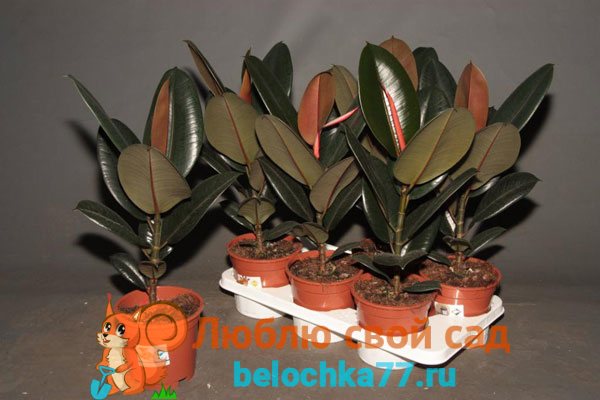

If the rubber plant likes the growing conditions, it will produce 1 new leaf every week in the active growth phase. In winter, a period of dormancy begins. Water the plant gently with warm water, drying the earthy coma between waterings. In the heat, it is advisable to spray. This ficus also likes to wipe its leaves with a damp sponge.
Common varieties:
- Robusta - green leafy, unpretentious look;
- Abidjan - has burgundy veins on the leaf plates, which gives it originality;
- Belize - has a three-color color, the leaf is green in the center, and has white and pink spots at the edges, photophilous;
- Black Prince - so named for the almost black color of the foliage, it has no special care requirements;
- Melany - has a compact crown, branches willingly, which makes it different from other varieties;
- Tineke is a tricolor variety with white, pistachio and green leaves, whimsical, gets sick from improper care.
Ficus rubber: video

